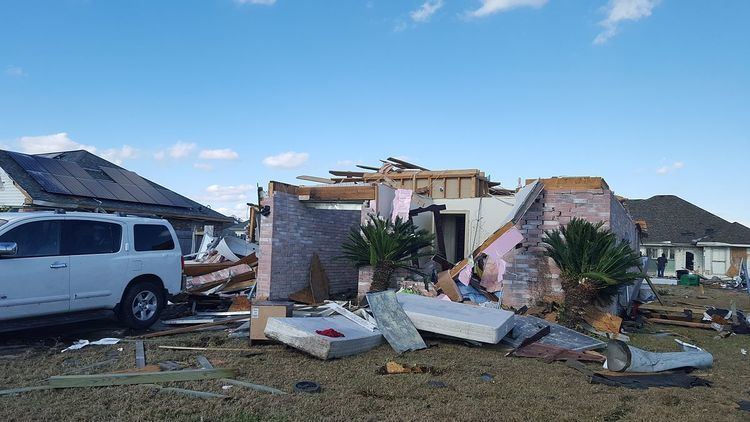Tornadoes confirmed 61 confirmed | Max rating | |
 | ||
Type Tornado outbreak
Extratropical cyclone
Winter storm Duration February 23, 2016 (2016-02-23) – February 24, 2016 (2016-02-24) Duration of tornado outbreak 1 day, 13 hours, 48 minutes Maximum snowfall or ice accretion 17.0 in (43 cm) snowfall – near La Porte, Indiana
0.7 in (18 mm) ice accumulation – East Sangerville, Maine | ||
The tornado outbreak of February 23–24, 2016 was one of the largest recorded February tornado outbreaks in the United States in recorded history. The system responsible for the outbreak produced numerous strong tornadoes across the Gulf Coast and East Coast of the United States, killing 7 people. A total of 61 tornadoes were confirmed as a result of the outbreak.
Contents
In addition to the tornado outbreak, the storm complex also produced blizzard conditions in the upper Midwest, including Illinois, Indiana, Michigan, and even parts of southern Ontario in Canada. Snowfall totals of up to 17 inches (43 cm) were recorded in parts of the hardest hit areas by the snowstorm.
Meteorological synopsis
On February 23, the Storm Prediction Center issued a moderate risk for severe weather across parts of Louisiana, Mississippi, Alabama, Georgia, and the Florida Panhandle, including a 15% risk area for tornadoes. The first significant tornadoes of the outbreak moved across southeastern Louisiana and southern Mississippi that evening, leaving significant damage and three deaths. The towns of Livingston and Laplace, Louisiana sustained heavy damage from strong EF2 tornadoes, and another EF2 near Purvis, Mississippi killed one person in a mobile home. An EF3 tornado also caused major structural damage in Paincourtville, Louisiana before destroying an RV park in Convent, killing two people at that location. Three simultaneous waterspouts were observed over Lake Pontchartrain during the event as well. Later that night, a large supercell thunderstorm developed over the Gulf of Mexico and moved ashore, producing a destructive EF3 tornado in Pensacola, Florida. The tornado injured three people and destroyed homes, townhouses, apartments, and a GE warehouse.
The outbreak continued the following day as the Storm Prediction center issued another moderate risk across parts of the East Coast, again including a 15% risk area for tornadoes. Strong tornadoes impacted the East Coast states of Virginia, Pennsylvania, and North Carolina on February 24, killing four people. An EF1 tornado struck the town of Waverly, Virginia, killing three people in a mobile home, including a two-year old child. An EF3 tornado struck the town of Evergreen, Virginia, causing severe damage and killing one person at that location. An EF2 tornado caused major damage to homes near Oxford, North Carolina, and another EF2 tornado touched down near White Horse, Lancaster County, Pennsylvania, damaging up to 50 structures in the area. Another EF3 tornado occurred later that night near the Virginia town of Tappahannock, destroying multiple homes along its path. About 35,000 people in Virginia, 4,000 in Washington, D.C., and 47,000 in the Carolinas lost power due to the storms. Seven people in total were killed by tornadoes during the outbreak, and a total of 61 tornadoes were confirmed.
Winter storm
On February 23, a low pressure area developed near the east end of Texas and began to track northeastwards into the Mid-Atlantic States in the early hours of February 24. During this period, it also began to interact with some cold air on the back side of it, producing snow and ice in parts of the Ohio Valley, dumping as much as 17.0 in (43 cm) of snow. At the same time, ahead of the cold front, severe thunderstorms developed ahead of it, which would eventually lead to the tornado outbreak.
